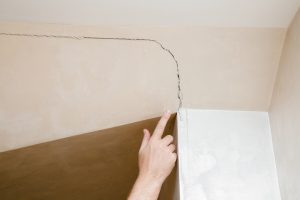 Cracked plaster can create several problems, especially when it is not properly repaired. There are several plaster repair solutions available, but not using one best suited to your situation can make the problem worse, especially if it is not a solution designed to handle further stress.
Cracked plaster can create several problems, especially when it is not properly repaired. There are several plaster repair solutions available, but not using one best suited to your situation can make the problem worse, especially if it is not a solution designed to handle further stress.
The Wrong Solution
For example, many repairs involve taping and drywall screws to fix a plaster crack. While it might fix the crack cosmetically, it is not a permanent solution by any means. To perform this repair, someone must scrape out the crack to gouge a larger groove over the crack, essentially widening it. This larger crack is then secured using drywalls screws or tape to ensure it is held in place at the time of repair. The crack is then filled in with joint compound with drywall tape or mesh.
While this is a similar treatment to how you would address a seam on normal drywall, the issue arises in that it is not a seam, but a crack. A crack appearing in your plaster is indicative of a larger problem, and makes solving that problem by patching it a problem. While it might address the issue momentarily, it will only address it cosmetically, and the crack is very likely going to appear again when the structure shifts again.
The Right Solution
Instead, it is best to work with a seasoned plaster repair crew to find the best solution for your problem. Sometimes it is possible to use plaster repair compounds that bind the existing plaster together to help seal and hold the crack. Other times it is best to locate the source of the shifting before attempting to repair the plaster, or it is best to leave the crack alone, it all depends on the circumstances surrounding your current situation.
In all cases it is best to not rush into a repair immediately. More often than not it is best to quantify how and why the crack occurred and what options are available to you. A poor repair might make the situation worse, resulting in larger cracks if the structure settles again. This is especially true for residential homes, where the cosmetic damage might become unrepairable.
Instead, check for potential causes of the crack. Moisture can often cause cracks, so look for leaks or high humidity locations. The type of crack that occurs can also be indicative of the problem. Large cracks are likely ones that have been repaired previously, whereas mid-size “spider cracks” are likely caused by settling. Another possible cause is disintegration, where the plaster protrudes through the wood lath and creates a bond.
If you have been able to establish a cause, it is time to call a repair crew. Many plaster repair blogs will suggest the original method we described above, but again that only addresses the cosmetic damage, not the larger problem as a whole. Finding a repair crew that can help you fix the problem in a way that prevents future damage is the best solution for your home and your plaster. Don’t settle for poor quality plaster and repairs, it is always best to invest in the best possible solution, especially when the product is so integral to your building. If you have cracks in your plaster, give us a call.
